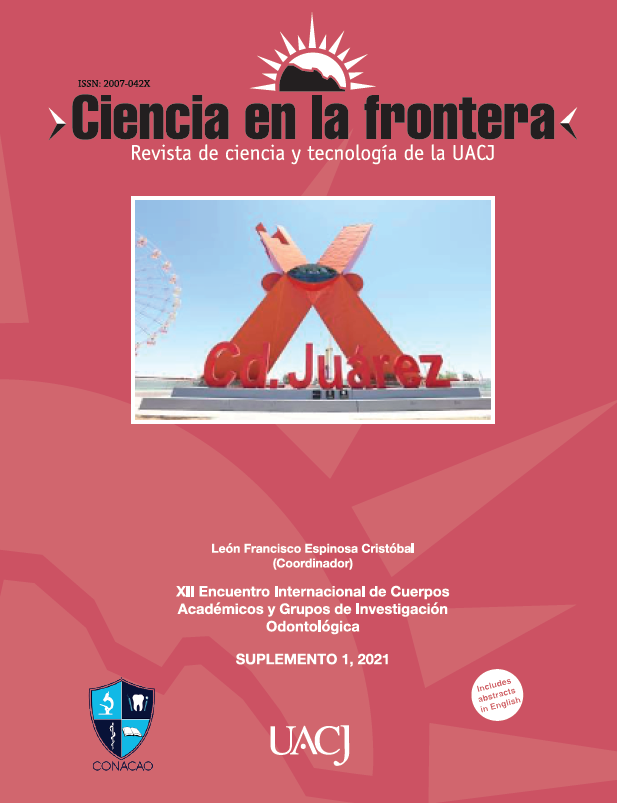Eficacia del flujo de trabajo digital en odontología restauradora: revisión
Keywords:
flujo de trabajo digital, escaneo dental, escaneo intraoral, cad-camAbstract
El propósito de ésta revisión, es el de analizar las instancias, los perfiles y responsabilidades que coexisten dentro de un protocolo de flujo de trabajo digital, así como discriminar estas instancias, frente a un protocolo de procesamiento protésico convencional. De igual forma se exponen las ventajas y restricciones, límites y condicionantes, involucrados en el flujo de trabajo digital, que comprometen el éxito del tratamiento protésico dental.References
Ahlholm, P., Sipilä, K., Vallittu, P., Jakonen, M. and Kotiranta, U. (2018). Digital Versus Conventional Impressions in Fixed Prosthodontics: A Review. Journal of Prosthodontics, 27: 35-41. doi:10.1111/jopr.12527.
Blackwell, E., Nesbit, M. & Petridis, H. (2017). Survey on the use of CAD-CAM technology by UK and Irish dental technicians. Br Dent J, 222: 689–693 doi:10.1038/sj.bdj.2017.407.
Joda, T, Gallucci, GO. (2015). The virtual patient in dental medicine. Clin. Oral Impl. Res. 26, 725– 726. doi: 10.1111/clr.12379.
Joda, T, Brägger, U. (2015). Digital vs. conventional implant prosthetic workflows: a cost/time analysis. Clin. Oral Impl. Res, 26:1430– 1435 doi: 10.1111/clr.12476.
Lambert H, Durand JC, Jacquot B, Fages M. (2017). Dental biomaterials for chairside CAD/CAM: State of the art. J Adv Prosthodont, 9(6):486-495. https://doi.org/10.4047/jap.2017.9.6.486.
Lin, W.-S., Harris, B. T., Phasuk, K., Llop, D. R., & Morton, D. (2018). Integrating a Facial Scan, Virtual Smile Design, and 3D Virtual Patient for Treatment with cad-cam Ceramic
Veneers: A Clinical Report. J. Prost. Dent. 119(2), 200-205. https://doi.org/10.1016/j.prosdent.2017.03.007
Luthardt R, Weber A, Rudolph H. (2002). Design and production of dental prosthetic restorations: basic research on dental CAD/CAM technology. Int. J of Comput Dent, 5(2-3):165-176. PMID: 12680050.
Prudente, M. S., Davi, L. R., Nabbout, K. O., Prado, C. J., Pereira, L. M., Zancopé, K., & Neves, F. D. (2018). Influence of Scanner, Powder Application, and Adjustments on cad-cam Crown Misfit. J. Prosth. Dent., 119(3), 377-383. https://doi.org/10.1016/j.prosdent.2017.03.024
Richert, R., Goujat, A., Venet, L. et al. (2017). Intraoral Scanner Technologies: A Review to Make a Successful Impression. J. Health. Eng. https://doi.org/10.1155/2017/8427595
Sen, N., & Us, Y. O. (2018). Mechanical and Optical Properties of Monolithic cad-cam Restorative Materials. J. Prosth. Dent., 119, 593-599. https://doi.org/10.1016/j.prosdent. 2017.06.012
Van der Meer WJ, Andriessen FS, Wismeijer D, Ren Y. (2012). Application of Intra-Oral Dental Scanners in the Digital Workflow of Implantology. PLoS ONE 7(8): e43312. https://doi.org/10.1371/journal.pone.0043312.
Vandeweghe, S, Vervack, V, Dierens, M, De Bruyn, H. (2017). Accuracy of digital impressions of multiple dental implants: an in vitro study. Clin. Oral Impl. Res. 28, 648– 653. doi: 10.1111/clr.12853.
Zweifel D, Bredell MG, Essig H, Gander T, Lanzer M, Rostetter C, Rücker M, Studer S. (2018). Total virtual workflow in CAD-CAM bony reconstruction with a single step free fibular graft and immediate dental implants, Brit J of Oral and Maxillofac Surg. 56, Issue 9, 2018, Pages 859-863,ISSN 0266-4356, https://doi.org/10.1016/j.bjoms.2018.09.010


